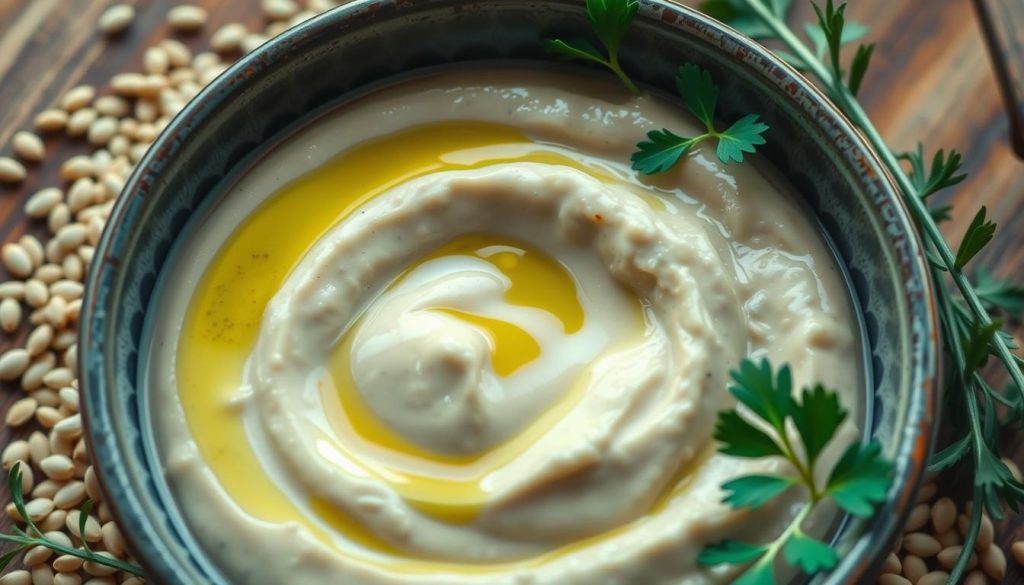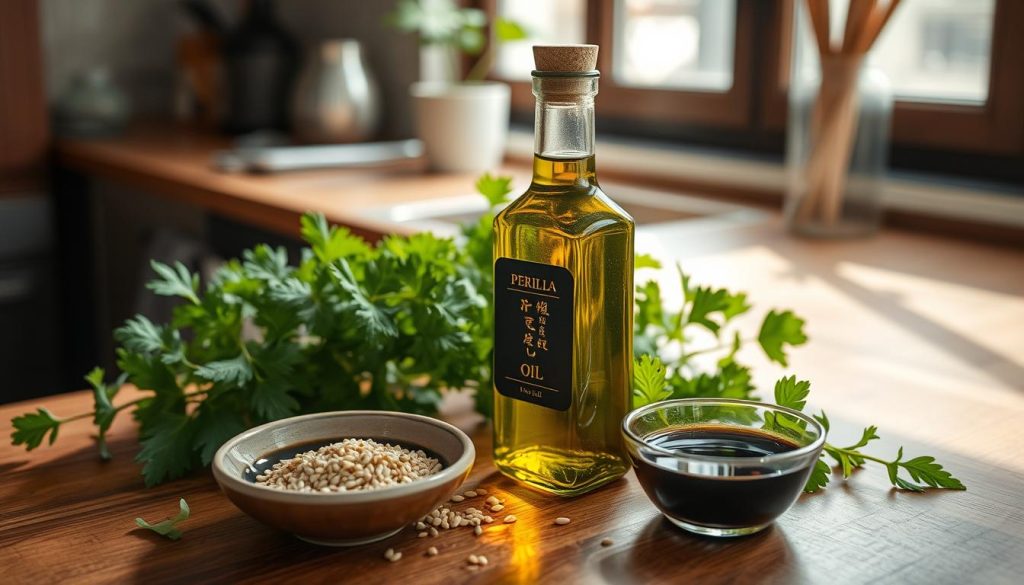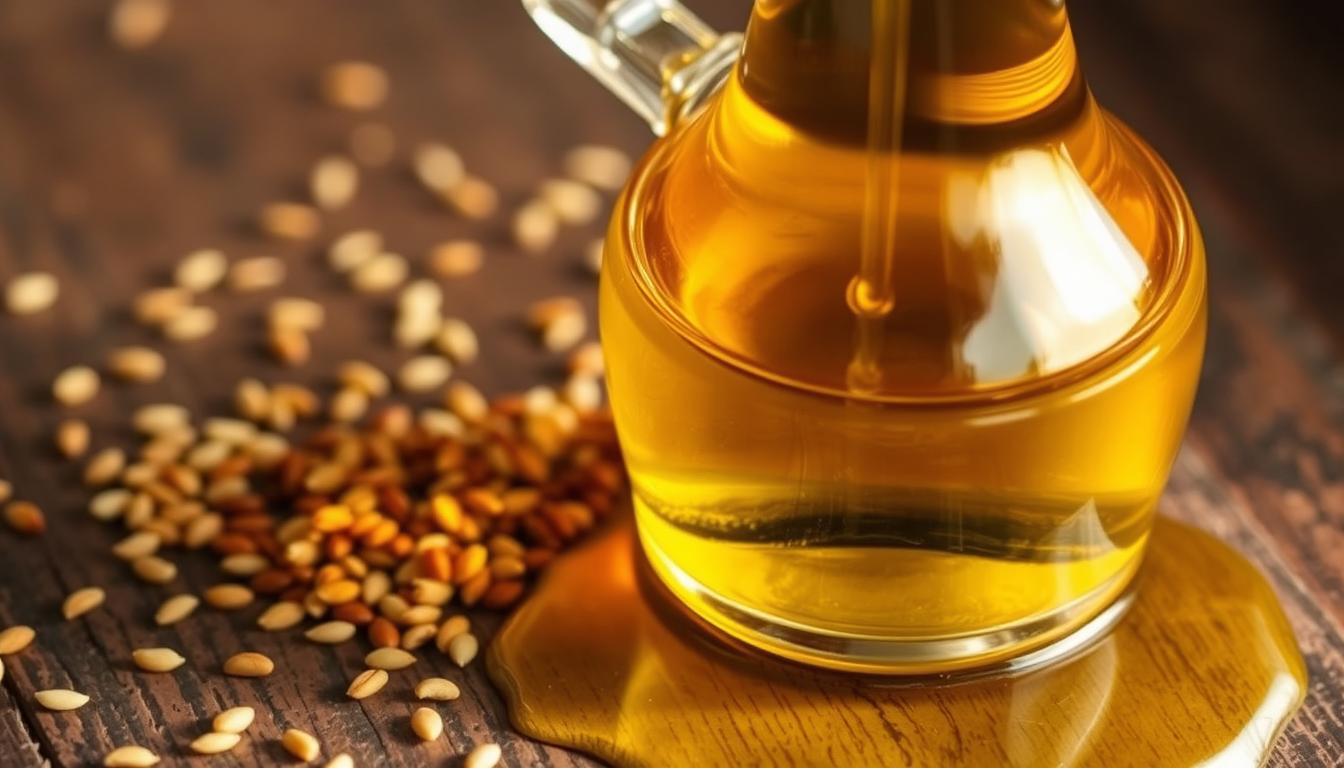Table of Contents
Sesame Oil Substitutes
Sesame oil is loved in Asian cooking for its nutty taste. Sometimes, you might need a different oil due to diet, allergies, or not having it. Luckily, many oils can replace toasted sesame oil, keeping your dishes tasty1.
We’ll look at different oils and ingredients that can stand in for toasted sesame oil. Options like walnut oil and canola oil are great for various dishes. They’re perfect for stir-fries, salad dressings, or when you need a high-heat oil1.
Key Takeaways
- Toasted sesame oil has a unique nutty flavor, while untoasted has a milder taste.
- Oils like peanut, walnut, and avocado can replace toasted sesame oil.
- Sesame paste, like tahini, offers a similar nutty flavor to toasted sesame oil.
- Choose a substitute based on its smoke point, taste, and recipe use.
- You can make your own sesame oil by toasting sesame seeds and blending them with a neutral oil.
What is Sesame Oil?
Sesame oil is a flavorful cooking oil made from sesame seeds. It’s loved in East Asian cooking, like Chinese, Japanese, and Korean dishes. It’s known for its nutty and toasty taste2.
Toasted vs Untoasted Sesame Oil
Toasted sesame oil comes from roasted seeds, giving it a deep amber color and strong nutty flavor3. On the other hand, regular sesame oil is made from raw seeds. It’s lighter in color and has a milder taste2.
Both kinds of sesame oil are good for you, full of omega fatty acids, vitamin E, and minerals like magnesium and calcium2. But toasted sesame oil is often chosen for its richer flavor, which boosts the taste of many dishes.
| Feature | Toasted Sesame Oil | Untoasted Sesame Oil |
|---|---|---|
| Color | Rich amber | Pale, golden |
| Flavor | Intense, nutty | Subtle, mild |
| Production | Seeds are roasted before pressing | Seeds are pressed raw |
| Health Benefits | Omega fatty acids, vitamin E, minerals | Omega fatty acids, vitamin E, minerals |
Whether you like the bold taste of toasted sesame oil or the lighter taste of untoasted, it’s a great choice for cooking. It adds unique flavor and health benefits to many dishes around the world234.
Olive Oil: A Versatile Sesame Oil Substitute
Olive oil is a simple swap for sesame oil in many dishes. It doesn’t have the same nutty taste, but works well in marinades, sauces, and cooking4.
Light, extra light, or virgin olive oil are good choices. They have a milder taste than extra virgin olive oil. Olive oil’s fruity flavor can enrich dishes like sesame oil does5.
Olive oil is known for its health benefits. It has antioxidants and fats good for the heart4. Both olive and sesame oils are better than saturated fats5.
Olive oil is a handy substitute for sesame oil. It’s great for those who can’t find sesame oil or want a milder taste4. Olive oil has more nutrients like antioxidants, vitamins, and minerals5.
“Olive oil is a versatile and healthy substitute for sesame oil in many dishes, offering a unique flavor profile that can complement a wide variety of ingredients.”
When using olive oil instead of sesame oil, think about the oil’s smoke point. Refined olive oil can handle high heat, perfect for deep frying5. Sesame oil, however, has a lower smoke point5.
Olive oil is a tasty and practical swap for sesame oil. It lets home cooks explore new flavors while enjoying its health perks45.
Nutty Alternatives to Sesame Oil
Walnut oil and peanut oil are great if you want a stronger nutty taste. Walnut oil has a deep, toasted flavor but can’t handle high heat well. It’s best for dressings and cold dishes because it has a smoke point of 320°F6. Peanut oil, used a lot in Asian cooking, has a mild nutty taste. It’s good for stir-fries and frying because it has a high smoke point of 450°F6.
Walnut Oil
Walnut oil is a tasty substitute for sesame oil, adding a unique nutty flavor4. It’s full of omega-3 fatty acids, which might help lower inflammation and protect your heart4. Because it has a lower smoke point, it’s best for cold dishes like dressings and marinades6.
Peanut Oil
Peanut oil is a favorite in Asian cooking as a sesame oil substitute6. It can handle high heat, making it perfect for stir-fries and deep-frying with its 450°F smoke point6. It’s also packed with healthy fats, making it a good choice for your diet4.
| Oil | Smoke Point | Nutritional Profile |
|---|---|---|
| Walnut Oil | 320°F | High in omega-3 fatty acids, antioxidants |
| Peanut Oil | 450°F | High in monounsaturated and polyunsaturated fats, vitamin E |
“Nutty oils like walnut and peanut oil can add a rich, toasted flavor profile to dishes when used as a substitute for sesame oil.”
Looking to try new flavors or want a healthier option? Walnut oil and peanut oil are great substitutes for toasted sesame oil in your cooking64.
Tahini: Sesame Paste as a Sesame Oil Substitute
Tahini is a creamy paste made from sesame seeds. It’s great for replacing toasted sesame oil in many dishes. It’s a key ingredient in Middle Eastern and Mediterranean cooking, especially in dips like hummus and baba ghanoush7.
Its rich, nutty taste makes it perfect for dressings, sauces, and marinades. To get the right consistency, you can mix it with water or a neutral oil8.
If you’re allergic to nuts, sunflower seed butter is a good choice. It tastes earthy like tahini8. Cashew butter is another great option. It has a creamy texture and nutty flavor, just like tahini89.
When you want that sesame taste, sesame oil is a good substitute. But it won’t be as thick and creamy as tahini8. Greek yogurt is also a surprising choice. It’s creamy and works well in dips and spreads87.

Looking for a Middle Eastern flavor or a tahini alternative? There are many options to try. Each has its own taste and benefits. By exploring these substitutes, you can make your recipes your own, fitting your taste and dietary needs9.
Avocado Oil: Rich and Buttery
Avocado oil is a great choice if you’re looking for a sesame oil substitute. It has a creamy texture and a mild, buttery taste. This makes it perfect for replacing sesame oil’s nutty flavor10. Plus, its high smoke point of about 480°F is great for cooking methods like frying and roasting10.
Avocado oil doesn’t have sesame oil’s toasted smell. But, it’s very versatile in cooking. It’s great for dressings, marinades, stir-fries, and baked dishes. It adds a rich, creamy base without taking over other flavors11. Also, it’s healthier because it’s full of good fats, like extra virgin olive oil10.
| Oil Type | Smoke Point | Flavor Profile | Best Uses |
|---|---|---|---|
| Avocado Oil | Around 480°F10 | Rich, creamy, and buttery | Frying, sautéing, roasting, dressings, marinades |
| Coconut Oil | High smoke point11 | Nutty, sweet, and slightly tropical | Baking, sautéing, stir-fries |
| Grapeseed Oil | Higher smoke point than EVOO11 | Neutral flavor | Frying, sautéing, baking, dressings, marinades |
| Olive Oil | Approximately 375°F for common EVOO, 410°F for high-quality EVOO10 | Rich, fruity, and earthy | Baking, sautéing, roasting, dressings |
| Canola Oil | High smoke point11 | Neutral flavor | General cooking, frying, baking |
| Sunflower Oil | High smoke point11 | Neutral flavor | Searing, sautéing, frying |
| Sesame Oil | Low smoke point11 | Unique nutty flavor | Finishing, stir-frying, sautéing |
When using avocado oil instead of sesame oil, remember the right ratio and cooking method11. You can use it 1:1, adding richness and texture without dominating the dish’s flavors11. Avocado oil is a versatile and tasty substitute for sesame oil, perfect for sautéing, baking, or making dressings.
Canola Oil: A Neutral Flavor Option
Canola oil is a great substitute for toasted sesame oil12. It has a mild, neutral taste that works well in many dishes13. It can handle high heat, making it perfect for frying and sautéing.
Using canola oil instead of sesame oil is beneficial because it doesn’t have a strong nutty taste13. This is ideal if you want sesame oil’s benefits without its distinct flavor12. Some people prefer canola oil because it tastes neutral compared to sesame oil.
Canola oil is also cheaper and easier to find than sesame oil12. It’s a good choice for both home cooks and professional chefs who need a sesame oil substitute13. Its neutral taste makes it versatile for many cuisines and cooking methods.

In short, canola oil is a reliable substitute for toasted sesame oil12. It has a neutral taste, can handle high heat, and is easy to find121314. It’s a great option for stir-frying, baking, or as a finishing oil when sesame oil isn’t available121314.
Grape Seed Oil: Light and Mild
Looking for a sesame oil substitute? Grapeseed oil is a great choice. It has a light, mild taste that won’t take over your dishes. This makes it perfect for using sesame oil’s cooking benefits without its strong nutty flavor15.
Grapeseed oil can handle high heat, up to 420°F (216°C), making it great for frying and sautéing. It won’t burn or give off a bad toasted taste like sesame oil might15. It’s ideal for stir-fries and dishes where you want a clean taste.
Grapeseed oil won’t overpower your food like sesame oil does. It blends well, letting other flavors stand out. This is great for getting sesame oil’s silky feel and high-heat use without its strong taste15.
| Oil | Flavor Profile | Smoke Point | Best Use |
|---|---|---|---|
| Grapeseed Oil | Light, mild | 420°F (216°C) | High-heat cooking, stir-fries, sautéing |
| Sesame Oil | Nutty, toasted | 410°F (210°C) | Flavor enhancement, marinades, dressings |
If you’re looking for a neutral-tasting oil to replace sesame oil, grapeseed oil is a top pick. Its light taste and high smoke point are perfect for many cooking tasks. You can use it without worrying about overpowering your dishes15.
Sesame Oil Substitute for Asian Cooking
Perilla Oil
Perilla oil is a great match for toasted sesame oil in Asian dishes16. It comes from the perilla plant, a mint family herb from East Asia. Perilla oil tastes nutty and umami-rich, similar to sesame oil17.
It’s perfect for salads, dressings, and sauces, but not for high-heat cooking because of its low smoke point17.
Perilla oil’s deep, earthy flavor is great for many Asian dishes, especially Korean and Chinese17. Though not as common as other substitutes, it adds real flavor to your cooking16.
| Oil | Smoke Point | Flavor Profile | Best Uses |
|---|---|---|---|
| Perilla Oil | 400°F (204°C) | Nutty, earthy, anise-like | Salads, dressings, low-heat cooking |
| Peanut Oil | 440°F (227°C) | Rich, nutty | Stir-frying, deep-frying |
| Almond Oil | 420°F (216°C) | Nutty, mild | Salad dressings, finishing |
| Walnut Oil | 320°F (160°C) | Nutty, rich | Salad dressings, finishing |
| Avocado Oil | 520°F (271°C) | Neutral, buttery | High-heat cooking, baking |
Remember, perilla oil has a unique taste and a lower smoke point than sesame oil17. It’s perfect for adding depth to your dishes, but not for stir-frying16.

“Perilla oil is a fantastic substitute for sesame oil in many Asian recipes, offering a similar nutty, umami-rich flavor. While it may not be as widely available, it’s worth seeking out for its authentic taste and versatility in low-heat cooking.”
Making Your Own Sesame Oil at Home
If you have sesame seeds, you can make your own sesame oil at home. Start by toasting ¼ cup of sesame seeds in 1 cup of neutral oil like canola or grapeseed until they’re golden18. Let the mixture cool, then blend it until it’s smooth. Strain the oil through a fine mesh sieve to get rid of the seed solids. This homemade oil can be stored in the fridge for up to 2 weeks and used like store-bought toasted sesame oil18.
Making your own sesame oil is a cost-effective and customizable way to do it. You can adjust the toasting level of the sesame seeds to get the flavor you want18. You can use it in many dishes, like stir-fries, marinades, dressings, and dips, giving them a rich, nutty taste.
To make homemade sesame oil, you need sesame seeds, a neutral oil, and some time. The process is simple, and the result is a flavorful oil that can enhance your cooking18. Making your own oil is a good way to save money and control the quality of your ingredients.
Homemade sesame oil has several advantages over store-bought versions19. You can adjust the toasting level to get the flavor you like, making it more personal18. Also, you can avoid preservatives and unwanted ingredients found in commercial oils19.
For those looking to cut down on oil or try healthier cooking, homemade sesame oil is a great option19. Toasting the seeds and blending them with a neutral oil makes a tasty substitute for store-bought oil in many dishes18.
“Homemade sesame oil is a game-changer in the kitchen. It’s easy to make, customizable, and allows you to take control of the quality of your ingredients.”
Making your own sesame oil at home is a good way to save money, control your ingredients, or try healthier cooking. With just a few steps, you can make a versatile, flavorful oil that will make your cooking better1819.
Flaxseed Oil: A Healthy Sesame Oil Alternative
Flaxseed oil is a great choice if you want a healthy substitute for sesame oil. It’s not the best for cooking at high heat because it burns at 225 degrees Fahrenheit20. But it’s perfect for dressings, sauces, and cold dishes. Its nutty taste and health perks really stand out.
Flaxseed oil has more omega-3 fatty acids than sesame oil20. This makes it a top pick for adding important nutrients to your meals. A tablespoon of flaxseed oil has 120 calories, 9.2 grams of good fats, and only 1.2 grams of bad fats20. It’s better for your heart than sesame oil.
Sesame oil lasts longer, up to 6 months at room temperature and a year in the fridge20. Flaxseed oil, however, is more fragile. It should be used within 6-12 months if unopened and 4-6 weeks after opening20. This is something to think about when picking between the two oils.

In the end, flaxseed oil is a nutritious and flexible choice for sesame oil. It’s great for adding omega-3s to your diet or trying new flavors. Flaxseed oil is definitely worth considering as a sesame oil substitute20.
Sesame Oil Substitute for Salad Dressings
When making salad dressings, you can swap sesame oil for other oils. Olive oil adds a fruity depth. Avocado oil brings a buttery richness. Walnut oil adds a nutty taste21. Use them in the same amount as sesame oil for tasty dressings.
Sunflower oil is a neutral choice that won’t overpower other flavors. Grapeseed oil is light and mild, perfect for many dressing recipes21.
Choosing the right oil for salad dressings is key. Think about the oil’s smoke point, texture, and taste. This ensures it fits well with the dressing’s other ingredients22.
| Oil | Smoke Point | Flavor Profile | Best Use |
|---|---|---|---|
| Olive Oil | 375-400°F | Robust, Fruity | Salad Dressings |
| Avocado Oil | 375-400°F | Rich, Buttery | Salad Dressings |
| Walnut Oil | 320-400°F | Nutty | Salad Dressings |
| Sunflower Oil | 440-450°F | Neutral | Salad Dressings |
| Grapeseed Oil | 420°F | Light, Mild | Salad Dressings |
Exploring these oils can make your salad dressings both tasty and pretty. Choose from olive oil’s boldness, avocado oil’s creaminess, or walnut oil’s nuttiness. These sesame oil substitutes for salad dressings can take your dishes to the next level4.
High Heat Alternatives to Sesame Oil
When you need to cook at high heat, like frying or sautéing, some oils are better than others. Avocado oil and grapeseed oil are top picks. They can handle high heat without burning or tasting bitter23.
Avocado Oil
Avocado oil tastes rich and buttery, similar to sesame oil. It’s great for cooking at high heat. It can reach up to 520°F (271°C) without burning or losing flavor24.
Grapeseed Oil
Grapeseed oil has a light, mild taste. It’s perfect for dishes where you want the other flavors to shine. It can handle up to 420°F (216°C) well24.
| Oil | Smoke Point | Flavor Profile | Best Use |
|---|---|---|---|
| Avocado Oil | 520°F (271°C) | Rich, buttery | Searing, broiling, stir-frying |
| Grapeseed Oil | 420°F (216°C) | Light, mild | High-heat cooking, highlighting other ingredients |

“For cooking at high heat, avocado oil and grapeseed oil are excellent alternatives to toasted sesame oil, as they can withstand intense temperatures without burning or imparting bitterness.”
Knowing how different oils perform helps cooks choose the right one for high-heat cooking. This way, they can replace toasted sesame oil with confidence2324.
Sesame Oil Substitute for Flavor and Finishing
Looking for a nutty flavor without sesame oil? Try walnut oil and almond oil25. Walnut oil adds a rich, sweet taste to sauces and cold dishes25. Almond oil gives a strong nutty flavor to roasted veggies and grilled meats25. Use these oils sparingly for flavor, not for cooking at high heat.
Walnut Oil
Walnut oil adds a warm, nutty taste to many dishes. It’s great with both savory and sweet foods. Try it on roasted veggies, in salad dressings, or on grilled meats and fish.
Almond Oil
Almond oil is a great sesame oil substitute for a toasted flavor. Its nutty taste is perfect for stir-fries, grain bowls, and sautés. Use it sparingly to avoid overpowering other flavors.
Remember, use these oils in small amounts for flavor, not for cooking at high heat. Their delicate flavors can get lost in strong heat. Save them for low- to medium-heat or as a drizzle over finished dishes.
Tips for Using Sesame Oil Substitutes
When you’re using sesame oil substitutes, remember a few important things. The taste of the oil you choose might not be the same as sesame oil. So, start with a small amount and adjust it to your liking4. Also, think about the oil’s smoke point. Oils like walnut and flaxseed are better for cold dishes because they have lower smoke points4.
Try out different sesame oil substitutes to see what works best for your dish41. For example, peanut or avocado oil is great for stir-fries and frying because they can handle high heat41. On the other hand, walnut oil or Chinese sesame paste might be better for dressings and marinades41. It’s all about finding the right fit for your recipe and cooking method.
Some sesame oil substitutes, like perilla oil, might not be safe for people with sesame allergies2. Always check if the oil you choose is safe for you, especially if you have food allergies. With a bit of trial and error, you can find the perfect substitute to make your dishes even better.
Visit our Medium Page : The Refinado




















